Cucurbits: Cucumbers and Squash
Site and Soil
Cucurbits grow best in full sun sites with good air circulation and prefers soil that is moist, well drained, fertile and rich in organic matter. The soil's pH should range from 5.5 to 6.8. Lime and fertilizer rates of application should be based on periodic soil tests. Natural fertilizers such as compost and manures, and slow-release commercial fertilizers along with limestone are effective when tilled into soil before planting time.
Varieties
There are many varieties of cucumbers and squash with great variation in shape, size, color, taste and texture. These plants are herbaceous (non-woody) annuals. Summer squashes are harvested as immature fruit, while winter squashes are harvested as mature fruit.
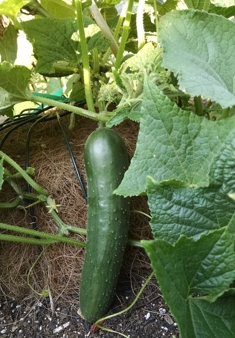
Image by Susan Pelton
Varieties of Cucurbits Suitable for Growing in Connecticut
| Pickling cucumbers | Alibi (res. to DM), Calypso (res. to DM, PM, angular leaf spot), County Fair (res. to bacterial wilt),Cross Country (resistant to angular leaf spot, DM), Little Leaf-19 (less attractive to Cucumber beetles, res. to DM), Score and Premier (both resistant to anthracnose) |
| Slicing cucumbers | County Fair (res. to bacterial wilt), Dasher II (res. to DM. PM), Diva (res. to DM), General Lee (res. to DM), Marketmore 76 (res. to DM, PM) |
| Bush Scallop | Peter Pan, White Ruffles, Sunburst |
| Spaghetti | Orangetti, Vegetable Spaghetti,Tivoli (bush-type) |
| Summer Green | Seneca Zucchini, Zucchini Elite, Cocozells Bush, Ambassador, Milano, A and C Zucchini improved |
| Summer Yellow | Early Prolific Straight neck, Seneca Prolific, Sundance, Dixie, Goldrush, Multipik |
| Winter | Waltham Butternut, Buttercup, Bush Buttercup, Gold Delicious, Table Queen, Cream of the Crop, Blue Hubbard, Golden Hubbard |
Planting
Cucurbits are warm season crops that must be planted after all danger of frost is past and the soil has warmed.
They grow best at temperatures between 65ºF to 75ºF. Seeds germinate poorly at low soil temperatures, therefore, wait until the soil is 60ºF before planting. Plant seeds one inch deep and 12 inches apart in rows 40 inches apart, or plant several seeds in hills that are three feet apart. Thin plants in rows so they are two to three feet apart and thin plants in hills to two or three plants per hill. For vine-type squash, thin plants four to six feet apart.
Care
It is important to control the weeds through frequent shallow cultivation and/or with the use of mulches. A black plastic mulch stops all weed growth and can help in warming the soil. If using an organic mulch, wait until early July before laying it down to allow the ground to warm. Cultivate all the weeds before applying the mulch. Desirable materials include straw, shredded leaves or rotted sawdust. Hay should be avoided because it may contain weed seeds. Grass clippings can also be used as long as the lawn was not treated with an herbicide.
Cucumbers and squash require a plentiful supply of water. Keep the soil evenly moist throughout the season. If it does not rain, an application of an inch of water per week should be sufficient.
Cucumber plants may be monoecious with male and female flowers on the same plant, gynoecious, with predominately female flowers (a few monoecious seeds may be included for pollination), or parthenocarpic which do not require pollination for fruit to set. Squash plants are monoecious, having male and female flowers on the same plant. Male blossoms appear first on a long stalk which often lifts the flower above the foliage. The female flowers are on a short stalk that resembles a small fruit. Squash requires cross-pollination, which is done mainly by bees or other insects.
Different varieties of squash will cross-pollinate, so do not save seed if different varieties are grown in the same area and flower at the same time. Cross-pollination will not affect the look or taste of this year's fruit. It can affect the look and taste of the squash grown from the seed of the cross-pollinated plants.
Bush varieties are excellent choices for gardeners with small plots. Most of the summer squash are bush varieties.
Harvest
Harvest cucumbers and summer squash throughout the growing season. Pick summer squash with elongated fruits when they are less than three inches in diameter and up to eight inches long.
Scallop squashes are harvested at three to four inches in diameter. Winter squash should be picked when mature and fruits have hard rinds. If pumpkins and winter squash are picked prior to the seeds filling out then the plant will use starch reserves from the flesh to fill out the seeds resulting in a poorer flesh quality. Acorn and delicata squash along with pie pumpkins may be eaten immediately after harvest but butternut, Hubbard, and kabocha should be cured before storing or eating. Cure by leaving fruit for 5-10 days at 80ºF with 80-85% relative humidity and night temperatures above 60ºF. Typically the skins should harden slightly. This is especially important for squash that will be stored long-term.
Diseases, Insects, and Other pests
Cucurbit plants are subject to insect pests, mites and diseases. Their damage can be reduced by taking some preventive measures such as planting disease-free seed or transplants, selecting disease-resistant varieties, removing and destroying all diseased plants, controlling weeds properly, using crop rotation and keeping the garden and nearby area free of debris.
Blossom end rot of fruits may be caused by inadequate or uneven water supply and/or excessive nitrogen and certain other conditions which interfere with calcium nutrition in the fruit. Internal hardening, discoloration, or tissue collapse may be present even if there are no outward signs. Maintain a consistent water supply (1-2" per week) and mulch around plant bases to help conserve moisture during hot, dry periods. Fertilizers should have low nitrogen, look for ratios of 4-12-4 or 5-20-5. Soil pH should be in the 6.0-6.5 range. There are no resistant varieties. Blossom end rot can also affect eggplant, peppers, tomatoes, and watermelon.
Diseases
| Angular Leaf Spot Pseudomonas syringae pv. lachrymans |
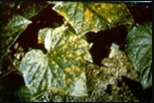 |
Angular, water-soaked spots 1/8" to 1/4" across. Later spots dry up and drop out of leaf. Spread by moist, warm weather, overhead watering, and infected seed. Use a copper-based fungicide at the first signs of an infection. |
| Anthracnose Colletotrichum orbiculare |
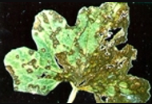 |
Light brown spots near veins, 1/4" to 1/2" across on foliage. may fall out to give 'shot-hole' appearance. On fruit, sunken spots, pink at first, later turning black. Humid, rainy weather will promote this disease. Will survive on crop residue. Plant resistant varieties or use a fungicide labeled to control anthracnose as a preventive measure if it has been a problem in the past or at the first signs of an infection. |
| Bacterial Wilt |  |
Individual leaves wilt and turn dull green. Gradually the entire plant wilts and dies. |
| Downy Mildew | 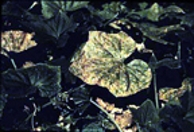 |
Yellow, angular spots within vein margins on upper sides of leaves. Grayish-purple fungus growth on underside of leaves. Fruit not affected. Plant resistant varieties. |
| Powdery Mildew Podosphaera xanthii and Erysiphe cichoracaearum |
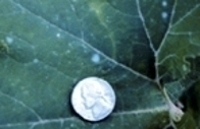 |
Powdery gray-white growth on leaves and petioles. Premature defoliation often occurs. Fruit may be affected. Plant resistant varieties or use a fungicide labeled to control anthracnose as a preventive measure if it has been a problem in the past or at the first signs of an infection. |
Insect Pests
Click on the highlighted links for control options
| Cucumber Beetle |  |
Beetle 1/5" long, yellow, three black strips down back. Generally appear at the end of May. Adults overwinter in debris in or near the garden. Transmits wilt disease. |
| Melon Aphid | 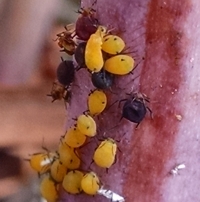 |
Small, greenish-yellow to black insects found on new growth and underside of leaf. |
| Spider Mites | 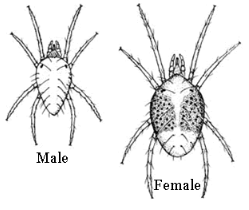 |
Very small, yellow or reddish mites. Yellowish spots on foliage. Webs may be seen. |
| Squash Beetle | 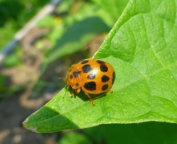 |
A copper-colored 14-spotted lady beetle, the larvae feed on the underside of the leaf, the adults on the top of the leaf and the rind of the fruit. |
| Squash Bug | 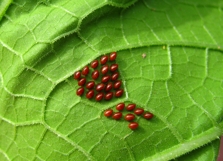 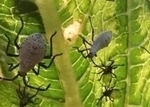 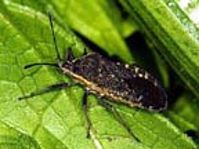 |
Adults are flat, brown with orange on the abdomen, about 3/4" long. Young are gray with black legs. Eggs are brownish and in patches on stems and underside of leaves. |
| Squash Vine Borer |  |
White larvae of a clear-winged moth bore into stems of pumpkins and squash. Overwinters as a pupa in the soil, emerging in late June. |
Please contact the UConn Home and Garden Education Center for control suggestions. Despite good cultural practices, pests and diseases at times may appear. Chemical control should be used only after all other methods have failed.
For pesticide information or other questions please call toll free: 877-486-6271.
All images ©UConn H & G
Revised by the UConn Home and Garden Education Center, 2016
Issued in furtherance of Cooperative Extension work, Acts of May 8 and June 30, 1914, in cooperation with the U.S. Department of Agriculture, the Dean of the College, Cooperative Extension System, University of Connecticut, Storrs. The Connecticut Cooperative Extension System is an equal opportunity employer and program provider. To file a complaint of discrimination, write USDA, Director, Office of Civil Rights, Room 326-W, Whitten Building, Stop Code 9410, 1400 Independence Avenue, SW, Washington, DC 20250-9410 or call (202) 720-5964.